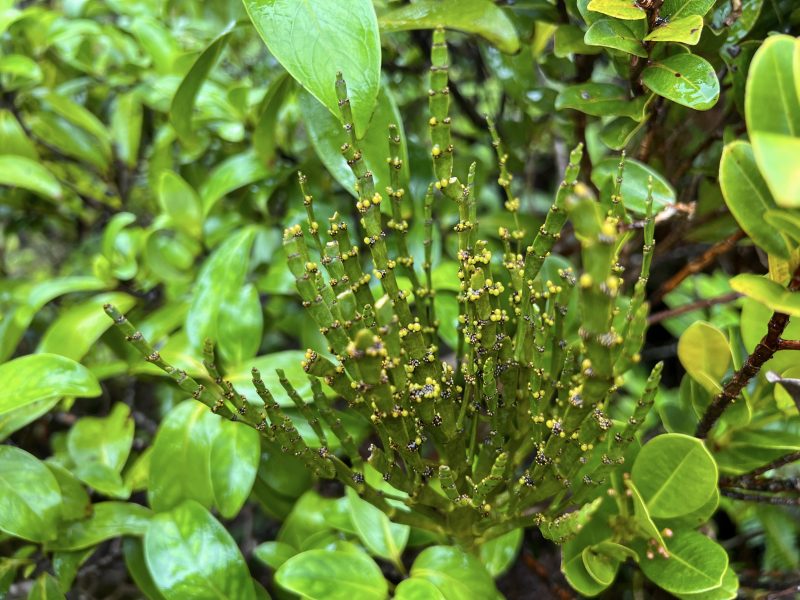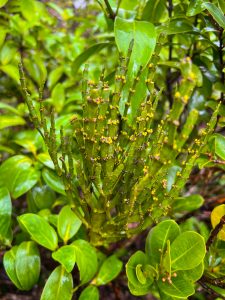Flora of Hawaii: Hulumoa

Hulumoa or Kaumahana is a native plant: There are four endemic and two indigenous species that is fairly common and can be found on all of the Hawaiian Islands. This species is hemiparasitic on a variety of Hawaiʻian trees.
Hawaiʻian name meaning: Hulumoa means “Chicken feathers” and Kaumahana means “warm perch”
Botanical Name: Korthalsella complanata
Family: Viscaceae (Mistletoe family)
Range: Uncommon parasite on ʻohia, lama, lonomea, or ʻakoko. Found in dry, mesic and wet forests, open bogs, parasitic on a broad range of hosts. Perennial subshrub shrub, which means it will grow year after year. Oahu to Hawaii Island. The greatest concentration of Korthalsella is in Hawaiʻi, where it is abundant in some places, such as the Keanakolu area on the island of Hawaiʻi,
Plant: The strange-looking mistletoes in Hawaiʻi, with their enlarged stems and reduced leaves, resemble aerial cacti. All species are virtually leafless parasitic herbs that grow on the branches of woody plants and obtain their nourishment from them. The plant is generally erect. Cylindrical branches of uniform width in a single plane; Korthalsella remyana has branches at right angles.
Branches: Jointed, flattened green branching stems are about 4 to 10 inches long.
Flowers: Tiny inconspicuous flowers and fruit may attach at the joints.
Seeds: Mistletoe seeds are dispersed by animals (birds as- sociated with host trees, including native birds and intro- duced birds such as the khalij pheasant), strong winds, and water. Also, seeds of Korthalsella species are often explosively ejected from the fruits.
The Hosts: Mistletoes infect the stems and branches of native hard- woods such as Metrosideros polymorpha (‘ōhi‘a lehua), Acacia koa (koa), Myrsine sandwicensis (kōlea lau li‘i), Diospyros sandwicensis (lama), Sapindus (lonomea, or Hawai‘i soapberry), Nestegis (olopua), Eugenia (ni‘oi), and Chamaesyce (‘akoko). Although they are plant pathogens, they are also functional components of natural ecosystems in Hawai‘i, providing food and shelter for many creatures.
Origin of the Mistletoe tradition: The common name for these plants comes from the Old English mistiltan. The plant was venerated by the Druids, and the custom of hanging it at Christmastime and kissing under it was mentioned by Washington Irving.
Historic Quote: “For some varieties of plants cannot grow in the earth, and take root in trees, because they have no abode of their own and consequently live in that of others; instances of this are mistletoe and the plant in Syria called cadytas….”- Gaius Plinius Secundus Major (Pliny the Elder) Naturalis Historia Book XVI, circa 77 A.D.
Hulumoa (photo from the Poamoho trail) is the featured image on the banner of the December 1, 2022 HTMC newsletter.
Information gathered with assistance from John B. Hall.
Sources:
A Hiker’s Guide to Trailside Plants in Hawaii by John B. Hall – pgs. 78-79
Plants Found on O‘ahu’s Trails by Ken (Kenji) Suzuki, 2012 – pg. 17
https://www.marinelifephotography.com/flowers/viscaceae/korthalsella-cylindrica.htm

